Well look, another summer’s almost over and I’ve still not fully recovered from my bad case of blogging fatigue caused by writing too much in other places. But today I come here with something slightly more substantial than nothing, something which doesn’t even require that many words.
Of course I can’t stray too far from the area that has pretty much taken over my real life – literature. Hence this post shall be a TV pop culture meets literature sort of collection:
1. American Writers on Gossip Girl: A Deadly Adventure?
Last September, Gossip Girl came back with its second season in which Dan Humphrey landed himself an internship with a famous writer played by none other than Jay McInerney. How fitting for all parties involved!
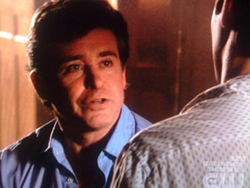
But then a few months later, I started to have doubts about what exactly fate might have in store for writers who appear on that show, even just indirectly. Because in “You’ve Got Yale!”, episode 16 of season 2, our budding writer Dan Humphrey could be spooted reading an old paperback of John Updike‘s Rabbit Redux in a trendy coffee house.
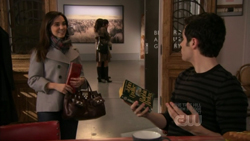
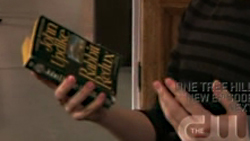
Now, in any other case I would have said ‘Congratulations, great product placement!’ or rolled my eyes and thought ‘OK, Humphrey’s the quiet, intellectual guy of the show, I get it (only he’s not)!’. But this whole thing seemed completely bizarre because this very episode was aired on January 19, 2009 and only a little more than a week later, on January 27, John Updike died…! When I heard the news of Updike’s death, that image of Humphrey holding Updike’s novel in his hands flashed up in my mind and I couldn’t help but wonder if it’s really safe for a writer to be featured on Gossip Girl… (Insert thoughtful silence here.)
2. Murakami, Murakami everywhere
Look who was scheduled for an operation at Seattle Grace in episode 18 of season 5 of Grey’s Anatomy (airing date March 19, 2009):
Richard Powers? And Murakami Haruki? Seems like the set designers were getting a little too carried away with their love for certain writers… Or maybe there is no such thing? Anyway, I sincerely hope the operation was a success and they sewed up Haruki properly again!
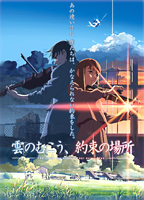 Speaking of my favourite portrayer of the Sheep Man:
Speaking of my favourite portrayer of the Sheep Man:
I saw the anime movie Kumo no mukou, yakusoku no basho (The Place Promised in our Early Days) the other day and while I was watching it I couldn’t help but notice certain similarities to Murakami Haruki’s works – the atmosphere, the parallel reality issue, the tower, the way the protagonist expressed himself in the monologues etc. Afterwards I saw the interview with the director Shinkai Makoto that was included on the DVD, which was shot in a place that looked like his work office. There were two screens in the background which showed important scenes and background designs for the film and then yes, I noticed in stack of two books drawn for the film one book I actually own:
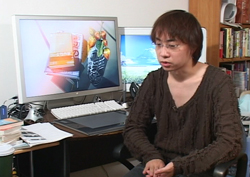
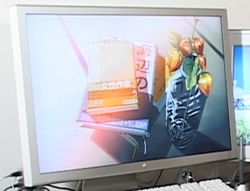
The blue book at the bottom is the Japanese hardcover edition of the first volume of Murakami Haruki’s Umibe no Kafuka/Kafka on the Shore complete with its obi and everything. I’m not sure if the image of the two books was used directly in the movie itself at some point because I’ve watched it only once so far and saw the interview afterwards, but expressing your love for literature and your favourite authors in every possible way, across all media, is simply admirable and obviously a pleasure for everyone involved ;)


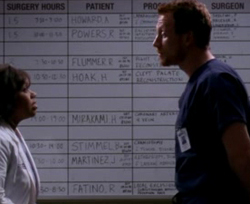
 I wouldn’t have bothered writing a review for this movie, this is just too remind myself of what sort of film not to stand in line and pay for ever again: The fact that I did go and see it was because my friend was really interested in the subject of young gay people in Japan. I jokingly mentioned to her that I’d made a promise to myself not to see any Japanese lo-fi indie films at the Berlinale anymore due to some very bad experiences in the past. I told her that most of these films featured very shaky and/or blurry camera work without any sort of aesthetic intention, completely talent-free amateur actors, a thin storyline and at least one disturbing masturbation scene.
I wouldn’t have bothered writing a review for this movie, this is just too remind myself of what sort of film not to stand in line and pay for ever again: The fact that I did go and see it was because my friend was really interested in the subject of young gay people in Japan. I jokingly mentioned to her that I’d made a promise to myself not to see any Japanese lo-fi indie films at the Berlinale anymore due to some very bad experiences in the past. I told her that most of these films featured very shaky and/or blurry camera work without any sort of aesthetic intention, completely talent-free amateur actors, a thin storyline and at least one disturbing masturbation scene. During World War II, Kayo Nogami, called Kaabee (a variant of okaa-san) by her children, is left too take care of her daughters Teruyo/Terubee and Hatsuko/Hatsubee (Mirai Shida, I’ve seen her in various dorama before, like 14 sai no haha and Watashitachi no kyôkasho) on her own because her husband Shigeru (Toobee), a professor for German literature, gets imprisoned under the Peace Preservation Law. To get through the hardships the war and her husband’s imprisonment bring with them, she can rely on the help from Yamasaki (Tadanobu Asano), a former student of her husband’s, her sister and an uncle. The film focuses on the everyday life during the war and lets you experience the propaganda and general madness from the inside. The family forms a sort of safe haven from all this. The life in the Noyami’s house is framed by the passing of the seasons, intouched by the war but affecting the house itself and its inhabitants. The movie finds a fine balance between serious, moving scenes, especially those set in prison where Noyami is treated so unfairly and cruelly or when his family reads out his letters, and the more lighthearted, funnier ones (usually involving Yamasaki).
During World War II, Kayo Nogami, called Kaabee (a variant of okaa-san) by her children, is left too take care of her daughters Teruyo/Terubee and Hatsuko/Hatsubee (Mirai Shida, I’ve seen her in various dorama before, like 14 sai no haha and Watashitachi no kyôkasho) on her own because her husband Shigeru (Toobee), a professor for German literature, gets imprisoned under the Peace Preservation Law. To get through the hardships the war and her husband’s imprisonment bring with them, she can rely on the help from Yamasaki (Tadanobu Asano), a former student of her husband’s, her sister and an uncle. The film focuses on the everyday life during the war and lets you experience the propaganda and general madness from the inside. The family forms a sort of safe haven from all this. The life in the Noyami’s house is framed by the passing of the seasons, intouched by the war but affecting the house itself and its inhabitants. The movie finds a fine balance between serious, moving scenes, especially those set in prison where Noyami is treated so unfairly and cruelly or when his family reads out his letters, and the more lighthearted, funnier ones (usually involving Yamasaki).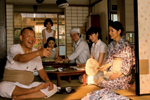 The film was slightly episodic but never boring, always touching, true, convincing and deeply humanistic. Sometimes it was trying a bit too hard to be emotional but I think that’s a common trait of mainstream Japanese movies. The cinematography was solid, on the conventional side of things but offered new insights into a country at war, from the point of view of ordinary people. The set design was brilliant, especially in the town scenes where you could see the propaganda posters and larger crowds of people.
The film was slightly episodic but never boring, always touching, true, convincing and deeply humanistic. Sometimes it was trying a bit too hard to be emotional but I think that’s a common trait of mainstream Japanese movies. The cinematography was solid, on the conventional side of things but offered new insights into a country at war, from the point of view of ordinary people. The set design was brilliant, especially in the town scenes where you could see the propaganda posters and larger crowds of people. During my research on Murakami Ryu I realized that Murakami’s been observing both mass culture & subculture phenomena from an almost outsider’s point of view while at the same time he himself is part of this mass media monster, this huge machinery (with both positive and negative qualities) in which everyone seems to be influenced by everyone in their output and instantly influences others the second they publish their ‘product’/output. As controversial as his thoughts and works might be, Murakami has already influenced a flock of younger writers, some of which have paid homage to his works through tiny details in their own works. As an example for that, here are a few connections between Murakami and anime:
During my research on Murakami Ryu I realized that Murakami’s been observing both mass culture & subculture phenomena from an almost outsider’s point of view while at the same time he himself is part of this mass media monster, this huge machinery (with both positive and negative qualities) in which everyone seems to be influenced by everyone in their output and instantly influences others the second they publish their ‘product’/output. As controversial as his thoughts and works might be, Murakami has already influenced a flock of younger writers, some of which have paid homage to his works through tiny details in their own works. As an example for that, here are a few connections between Murakami and anime: And then there’s Eureka seveN (2005), the current generation’s Evangelion, which I admittedly quite enjoyed, though not nearly as much as Eva. It was written by the highly celebrated screenwriter Satou Dai, who also wrote (episodes of) other brilliant anime series such as Cowboy Bebop, Wolf’s Rain, Ergo Proxy and Terra e…, to name just a few. He apparently made a cross-reference to Anemone, the female protagonist in Murakami’s Coin Locker Babies (1980) by naming the pink-haired Anemone, the oh-so-tormented pilot of the Nirvash LFO TheEND, after her. In the book, Anemone has an alligator called Gulliver and in the anime, Anemone’s pet is this weird mixture of a duck, a sheep and something indefinable that is called Gulliver, too.
And then there’s Eureka seveN (2005), the current generation’s Evangelion, which I admittedly quite enjoyed, though not nearly as much as Eva. It was written by the highly celebrated screenwriter Satou Dai, who also wrote (episodes of) other brilliant anime series such as Cowboy Bebop, Wolf’s Rain, Ergo Proxy and Terra e…, to name just a few. He apparently made a cross-reference to Anemone, the female protagonist in Murakami’s Coin Locker Babies (1980) by naming the pink-haired Anemone, the oh-so-tormented pilot of the Nirvash LFO TheEND, after her. In the book, Anemone has an alligator called Gulliver and in the anime, Anemone’s pet is this weird mixture of a duck, a sheep and something indefinable that is called Gulliver, too.